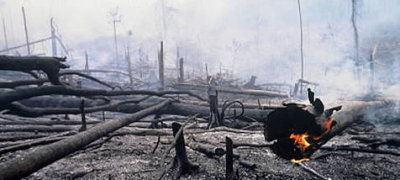Forestfires and air pollution
Where did the pollution come from ?
In 1997, severe Indonesian forestfires released smoke which remained stagnant over South-East Asia and smog which spread more rapidly across the Indian Ocean toward India. The different movement occurred because the pollutants were in different layers of the atmosphere.
This situation was exacerbated by El Niño, which had already increased the thickness of smog over the region.
At the same time, additional smog from African fires streamed over the Indian Ocean and combined with the smog from Indonesia, creating a huge aerial blanket of pollutants.

Between July and November 1997, the emissions from the Indonesian fires caused considerable air pollution throughout the whole Southeast Asian region. Hazardous particles found in smoke caused air-quality and health problems like asthma, upper respiratory infections, decreased lung function, and eye and skin irritation.
Deforestation in Indonesia
Indonesia was still densely forested as recently as 1950. Forty percent of the forests existing in 1950 were cleared in the following 50 years.
Millions of hectares of forest are being lost as native forest is cleared to make way for industrial timber plantations for the pulp and paper industries, for conversion to crop plantations like oil palm as well as mining activities.
However, logging and especially illegal logging, is said to be one of the main causes of forest loss.
Burning is the cheapest and rapidest way to clear forest land before it can be turned to crop plantation. Large areas of South Asian forests are being burned each year. This can cause tremendous atmospheric pollution when fires become uncontrollable.
For more informations visit the page "Dark skies" of the EOEdu website.
